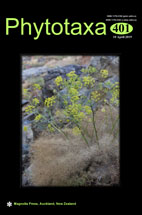Abstract
All species of Podostemaceae grow only in rocky rapids and waterfalls and usually consist of separate populations. Previous studies found paraphyletic species among such species and suggested that possibly more species are paraphyletic. Molecular phylogenetic analyses and comparative morphology using samples from different populations found that Cladopus fallax C.Cusset and Polypleurum wallichii (R.Br. ex Griff.) Warm. are paraphyletic to C. taiensis C.Cusset and P. schmidtianum Warm., respectively. It is interpreted that the daughter species markedly differentiated morphologically from a population of the mother species, and perhaps paraphyletic speciation is associated with allopatric speciation. Molecular and morphological data indicate that P. wallichii is conspecific with P. stylosum (Wight) J.B.Hall, so the redefined P. wallichii is widely distributed in southern and southeastern Asia.

